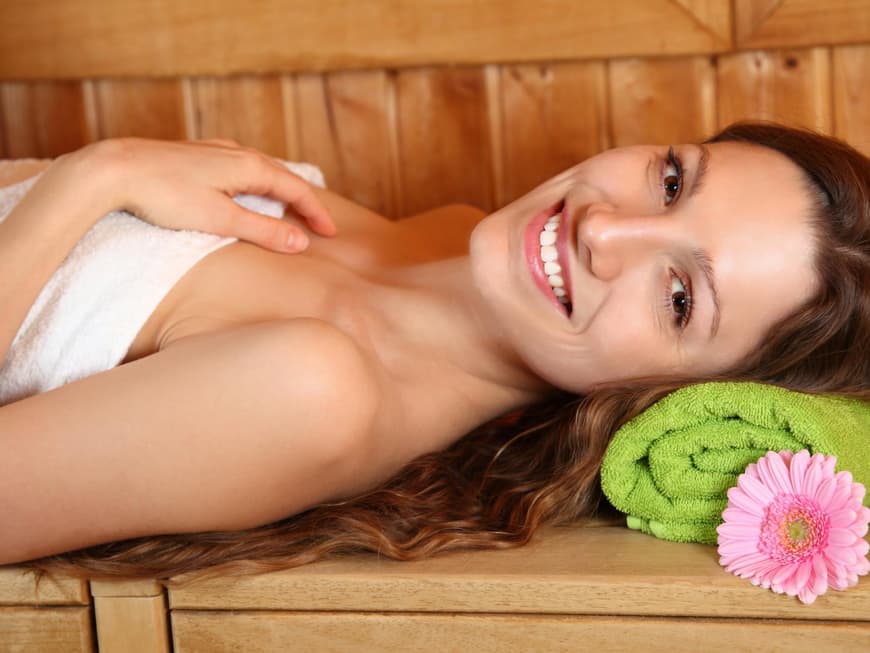The warming bath program
A warm bath invigorates and warms the body, especially in the cooler months of the year. Women in particular like to take a warming bath with a fragrant bath additive, which is perhaps not least due to the fact that women generally get cold more quickly than men. The different sensation of cold is due to various physical factors.
It is important to pay attention to the time and temperature of the bath so that the skin does not become too dry and proper relaxation occurs. The body warms up best at a water temperature of around 37 degrees Celsius - this corresponds roughly to human body temperature. The optimum bathing time for warming up is between ten and twenty minutes. If the shivering comes from cold feet, foot baths can help. Simply add hot water and rosemary oil to a container of water at body temperature (approx. 37 degrees Celsius). This not only ensures that the warmth goes through the whole body from below, but also helps with circulatory problems.
Warming foods: From tea to porridge

Warmth from the inside? As we can't wrap our bodies in a warm coat from the inside, we need a substitute - in the form of warming food. Warm soups are therefore particularly suitable as starters or main courses in the cooler months of the year. A stew with fresh vegetables also supports the warming program and the vegetables also provide a sustainable supply of nutrients that strengthens the immune system. Oven-baked dishes in particular can also have a warming effect. Fruit and raw vegetables, on the other hand, which contain a lot of water, only increase the constant shivering. Because they are cold, the body has to expend a lot of energy to digest them properly - energy that the body lacks when producing heat.
To start the day warmed up, for example, toast the bread or prepare a warm porridge with oat flakes. Frostbite sufferers, on the other hand, should avoid yogurt, which has a cooling effect and also increases mucus production if you have a cold - which can also be unpleasant. In the evening on the sofa or to warm up after an autumn walk, teas are best. While the flavors peppermint, chamomile or even green and black tea tend to cool the body down, warming varieties such as fennel, aniseed or cinnamon tea are suitable for chilblains. Ginger tea also provides extra warmth due to its pungent substances, which is just one of the beneficial effects of the Far Eastern medicinal plant.
Protection from the cold from top to bottom
Just squatting indoors in the fall? Sure, when it's pouring from the sky again, it's often more pleasant than going for a Sunday walk. But on rain-free days, outdoor exercise helps to get the body going. To avoid the constant shivering outdoors, it's best not to just wrap yourself in a warm coat. It should be said that it is a myth that most body heat is lost through the head. The myth is said to have originated from a military study in which test subjects were put into survival suits, but were not given any headgear. Naturally, the participants inevitably lost most of their body heat through their heads. However, if they had also worn appropriate head protection, they would probably only have lost around ten percent of their heat through their heads. So every part of the body should be well wrapped up.
However, the body parts should not only be sufficiently shielded from the cold, but should also be at a sufficient distance from sources of cold. For example, it is important that your feet do not transfer heat to the cold ground. This is because if your feet are cold, the cold is conducted through your whole body. So when it comes to footwear, opt for insulating inner soles - made of wool, for example - and slip into your shoes with natural and breathable cotton socks if possible. Before putting on warm socks, you can apply a special cream with a heat-activating effect to your feet.
Shelter from the autumn storm with a comfortable temperature
While coats and coats wrap the body in warmth outside, the in-house heating system ensures a cozy, warm feeling inside. There are certain guidelines for a pleasant room temperature that prevents shivering. For example, the room temperature should be around 20 degrees Celsius - also for reasons of energy efficiency - and should not exceed this if possible. A guide value for the kitchen is 18 degrees Celsius and for the sleeping area around 17 degrees Celsius. Of course, everyone has their own comfort temperature and, especially in the fall, more heat is needed in the morning due to the first frost than at lunchtime, when the sun comes out from time to time. An intelligent heating control system that compensates for temperature fluctuations is therefore suitable for simple temperature control in the so-called intermediate season. The heating temperature is also lowered by sensors during ventilation. This is because, although people are understandably reluctant to put their cozy warmth at risk, ventilation is important despite the cold outside temperature. Just to prevent accumulated moisture in the four walls from leading to mold growth and to maintain the air quality, it is important to ventilate completely for about five minutes several times a day. This, along with other factors, is crucial for comfortable room heating.
Sweating, warming and strengthening the immune system

Sauna bathing not only strengthens the immune system, but also helps the body to adapt to changing temperatures. And who, if not autumn, brings with it changeable weather every year? In addition, going to the sauna naturally ensures that the body is warmed up completely. There are a few things you should bear in mind to make sure you don't shiver in the sauna: Take at least two hours (although eight to 15 minutes in the sweat room is sufficient), avoid going into the sauna on a full stomach if possible, take a warm, ankle-high footbath after cooling down (around 40 degrees warm) and, if necessary, take a rest period afterwards, although your feet should not get cold.
Small warmers for in between
To give yourself a pleasant feeling of warmth in between and to stop you feeling cold, heat plasters or heat wraps are suitable, which are available from pharmacies and other places. They continuously release heat to the body through the skin - for between 8 and 12 hours. In the evening or on a rainy Sunday, a mud pack can also provide warmth. Fango is a healing, warming mineral mud that is heated to around 50 degrees and applied to individual parts of the body. The "mud program" can also be carried out in the massage practice of your choice. The treated body parts can be wrapped with a cloth so that the heat is stored and penetrates deep into the body tissue after around 30 minutes. Another simple way to get up to autumnal operating temperature and counteract shivering at home or in the office is to use cushions with cherry stones, rye or spelt. If these are placed in the microwave at around 800 watts for around 90 seconds, they act as a good heat reservoir and, more importantly in the autumn season, as a good source of warmth.



